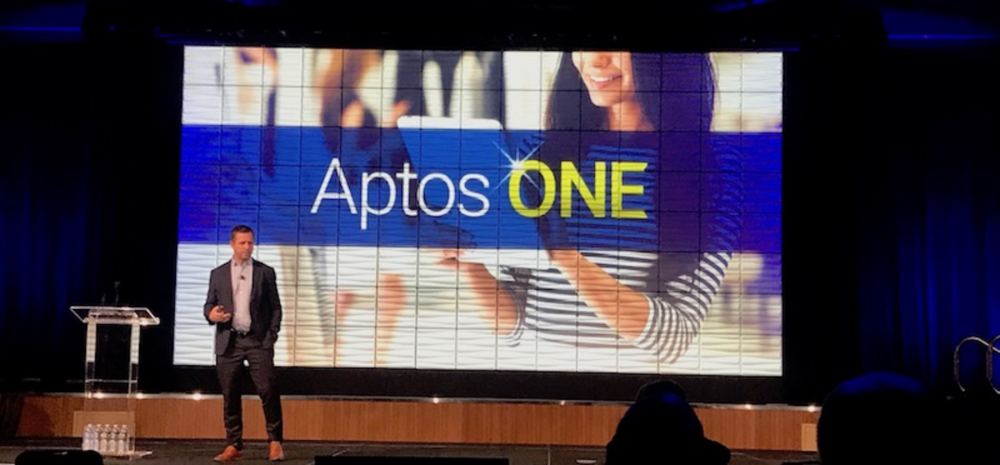The retail industry is changing. Conversations are driven by digital-savvy consumers, who demand quick service and seamless, agile, customer experiences both online and offline. They crave efficiency, and value authenticity, forcing retailers to shift their organizations towards personalization and customer-oriented storytelling across multiple channels.
On the backend, retailers rely on their tech stack to help execute their goals. But as strategies shift, so do technology needs. Aptos, a retail commerce platform, recognized this back in 2016, and started their own journey towards innovation with the introduction of Aptos Labs, a division committed to research and development, officially launched in 2017.
Onstage at Aptos Engage 2018 this week, CEO Noel Goggin introduced Aptos One, the fruit of those labors, and the company’s new endeavor into a fully-customizable, cloud-based retail commerce platform built off a growing microservices system, with a mobile-first design.
“Software is becoming much more dynamic,” Goggin said. “It’s a dynamic, living thing.”
Shifting to the cloud
During his keynote, Goggin shed light on the issues retailers face when navigating legacy tech operations. Data necessary to properly evaluate the success of omnichannel programs is often tangled in a web of complex systems within the stack. The customer journey becomes convoluted, with marketers struggling to piece the right data together to fully understand attribution.
“There’s a big disconnect in the path to purchase,” Goggin said, comparing traditional systems to a ball of multi-colored yarn. “…we have to start unraveling that ball, and simplify the core.”
The customer journey is no longer linear, Goggin said, but rather a “moving organism” with an array of touchpoints, opportunities, and “so many ways to disappoint your customer along the way.”
“There are no blueprints for the journey,” he said.
For Aptos, the solution was creating a new product structure that could handle both online and offline retailer needs.
The flexibility of the cloud allows Aptos to reorganize their offerings into a suite of microservices, and efficiently translate those services for mobile execution. Aptos kicked off by focusing on building out their point-of-sale solutions, and bringing existing services into the cloud.
“It’s the hardest problem to solve,” Nikki Baird, VP, retail innovation, said of POS as we chatted outside the session rooms at Engage. “There’s no point in leading a customer down a path if they can’t buy.”
Baird brought up a common example of defunct POS systems in brick-and-mortar locations: the frazzled associate stuck in one corner of the store with their tablet, because it’s the only place they can get the right connection needed to complete transactions. In this case, the associate is mobile in theory, but not truly in practice.
“At that point, you might as well just set up a register,” Baird said.
Under the hood
On the Engage main stage, Mike Verdeyen, product leader, and Ian Rawlins, strategy leader, demonstrated how the Aptos One mobile POS system worked by completing a pay-and-go transaction with Paper Source, a Chicago-based retailer and pilot customer, right on stage.
Just watched the #AptosEngage18 main stage turn into a pop-up store #retailtech pic.twitter.com/X4sXCLLdWN
— Amy Onorato (@ArtOnorato) April 17, 2018
Retailers with different needs can mix and match microservices like wishlists, product lookups, and pay-and-go to create what Rawlins calls “unique employee and consumer experiences,” which vary depending on retailer goals.
“Brands are using technology in ways they never have before to drive differentiation.” – Ian Rawlins on stage at #AptosEngage18 pic.twitter.com/tj4Sq9hz6S
— Amy Onorato (@ArtOnorato) April 17, 2018
“Brands are using tech in ways they never have before to drive differentiation,” Rawlins said.
Retailers can also develop their own custom microservices, given they’re built to integrate with the Aptos API.
“It’s not just technology, it’s a design philosophy,” Baird said, noting the need for retailers to view the microservices suite as a system of experience orchestration, rather than customization.
Looking ahead
Though the Aptos One platform is up and running, there’s still more work to be done — a deliberate decision made by the Aptos team as they shift their tech to a new format.
“We took a really careful approach to build something in a way that’s truly scalable,” Baird said.
The long-term vision is to continue developing their customer engagement, order lifecycle, extension, and merchandising (with the help of their recent TXT Retail acquisition) services under the Aptos One umbrella, fueling customer, employee and business partner experiences.
A deep dive on @TXTRetail and @Aptos_Retail integrations through the first six months post-acquisition at #AptosEngage18 pic.twitter.com/Vgmu6NLgdz
— Amy Onorato (@ArtOnorato) April 17, 2018
Doing that, however, requires the team to tweak and update their existing tech to make it more cloud-friendly, and develop new microservices to fill out the platform. In a way, it’s an ongoing development. Aptos Labs will serve as an incubator, working alongside innovation partners to develop services to fit needs for all retailers.
To do this, Aptos is increasing their R&D budget by 70 percent over the next two years, focusing on product innovation, and developing presence on the global market.
“We’re only at the beginning,” Goggin said.








